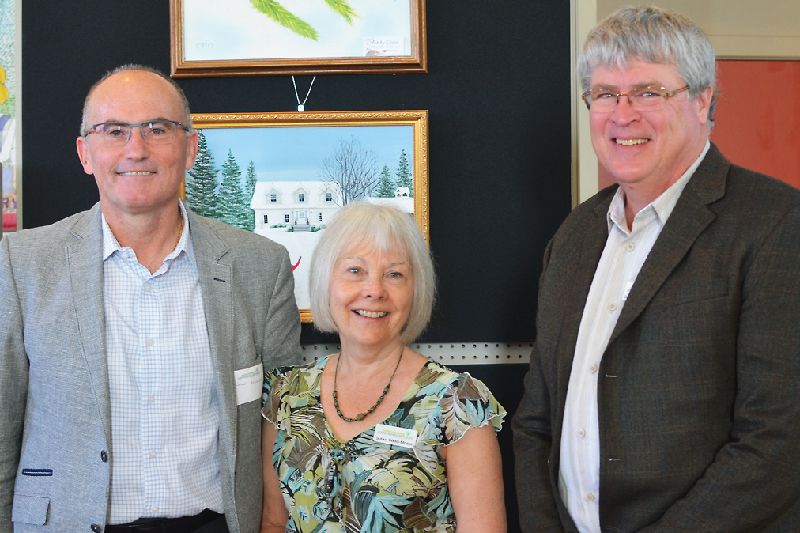Jeff Green | Jul 11, 2018
Dr. John Muscedere, from Kingston General Hospital and the Queen’s School of Medicine, is also the scientific director for the Canadian Frailty Network. The CFN is dedicated to improving care for the estimated 1 million Canadians who fit the definition of frail that the CFN has developed.
He was the keynote speaker at the Annual General Meeting of Southern Frontenac Community Services (SFCSC) last Friday morning (June 22) at the Grace Hall in Sydenham.
SFCSC provides programming for populations other than seniors through its food program, homelessness prevention program and other activities, but the agency has a primary focus on providing supports for seniors within the community.
As Executive Director David Townsend pointed out in his remarks, SFCSC has had increased uptake for most of its senior’s services over the last year, a 20% increase in the use of the Adult Day Program for the frail elderly, a 25% increase in the number of deliveries through its meals on wheels program, and a 6% increase in the number of rides provided for seniors.
“In all of those cases, we are providing more service than we are funded to provide by the LHINS (Local Health Integration Network, SFCS’s primary funder for senior’s programming). We do that because the need is there in the community, and the only reason we are able to do that is because of the funds that we raise each year from the community,” he said.
Townsend’s remarks paved their way for Dr. Muscedere, who hobbled to the stage on two crutches.
“I was attempting to stave of frailty for myself,” he said, “by taking a hiking trip in Scandinavia. That’s where I got a broken ankle.”
He started his presentation by talking about some global numbers. The number of people in the word age 0-64 is expected to go up by 22% by the year 2050. Over the same timeframe, the number of people 65 and over will go up by 188%, the number over 85 by 351% and the number over a hundred will go up by 1004%.
He said that this kind of information is behind all of the doom and gloom scenarios about the future of our health care system and the need for long-term care.
“People use a phrase that I detest, ‘the aging Tsunami’,” he said, “but the reality is that not all aging is the same, and as more people age, more people will also be aging well, aging healthily through exercise, nutrition, good social interaction, etc. There is a very real difference between chronological and biological aging, and this is important when you look at frailty.”
He put up a slide that featured a photo of an old, thin man, crossing a finish line.
“This a photo of Ed Whitlock, who set a world record by finishing the Toronto marathon in under four hours at the age of 85. He is not frail by any means, but if you saw him in a hospital bed, you might think he was.”
There is a clinical frailty scale, ranging from level 1 (very faint), to level 8 (terminally frail), and the CFN advocates to keep people from slipping down the scale, and for better supports and care systems for those who have reached advanced stages of frailty, from which they cannot recover. As well, dementia plays a key role.
“Where dementia is present, the degree of frailty usually corresponds to the degree of dementia,” said one of the slides.
In order to deal more effectively with frailty, the CFN advocates for better recognition of frailty, more study, and better organization of the healthcare system.
To end, Dr. Muscedere talked about Denmark, a country with a population that has completely revamped its healthcare system over time. Since the late 1980s, Denmark has focussed its resources away from hospitals and long-term care, and towards community-based medicine. In terms of seniors, home-based care is prioritized over long-term care facilities.
“We are a very long way from that model in Ontario,” said Muscedere, “and another key piece is that lack of integration in our system as compared to theirs. To address frailty, we need a multi-pronged approach including increased recognition, increasing evidence for its treatment and multi-institutional, multi-jurisdictional efforts to break down silos and implement holistic models of care in the system.”
The final point that be made was that frailty is not solely a healthcare issue, and that “better care for seniors living with frailty will only come through improvements in both health and social care.”
More Stories
- Province clarifies stance - Says Private Well Water Testing Will Continue
- Frontenac County Stays Internal for CAO - Appoints Kevin Farrell
- Addington Highlands Tax Bill Going Up 6.93%
- Perth Road United Church Donation to The Grace Centre
- 21 Years Of Dump Life Left At South Frontenac Waste Site
- Eclipse 2024 – Once In A Lifetime
- National Tourism Week
- NeLL Spring Open House and Anniversary Concert
- 25 years at Bishop Lake Outdoor Centre
- Grounds Contracts Down, Custodial Contracts Up In Central Frontenac
